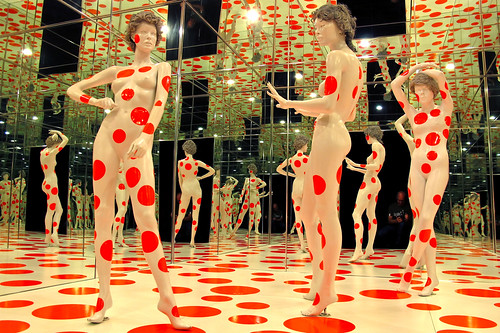There was an elderly pigeon walking along Finchley Road today. When he tired, h

e paused to contemplate a few sodden autumn leaves. London in the rain, he shrugged morosely. His glum little figure became a thing of memory as traffic moved and our taxi driver apologised profusely for his squeaky shoes. It's the rubber soles, he offered politely. Yesterday's taximan swore blue murder at an intrepid pedestrian, words that shocked my mother! But surprisingly, even he apologised at the end of the drive, with a somewhat complex tale about a cousin who wound up in prison because of... there are seven million detailed biographies entwined on these streets and no one is what they seem.

We have been swanning around in taxis in rainy London because Mum tumbled down a few mossy stone steps and a golf ball sized swelling bloomed around her ankle. But ice and my reiki righted the pain and we have travelled down Rotten Row where the horses canter, and past the Serpentine, spent hours in the National Portrait Gallery where the newly acquired bronze bust of Nelson Mandela resides beside portraits of Amartya Sen and Dorothy Hodgkin. This time Mum didn't return home determined to tear up her portraits as she is dramatically wont to do...
We are in London for my childhood friend's wedding at Langhams Hotel. A swanky affair! I wore a floaty sort of green ensemble, empire line, very Regency. Byron would have approved. And Father danced with far too many women. And almost no one knew I had just emerged from Rituximab infusions less than two weeks ago. And none of that matters anyway when I stand in awe of the magnificent exhibition of Diaghilev and his Ballet Russes at the Victoria and Albert Museum, surrounded by the living art

of Karsavina and Nijinsky, Stravinsky and Massine, Leon Bakst, Jean

Cocteau and a huge drop curtain detailing Picasso's Women Running on the Beach for
Le Train Bleu.
Most moving was the performance of the Little Angels, an all-female children's folk ballet troupe from Korea. Sadler's Wells theatre was full of Korean war veterans, for whom the troupe was created in gratitude, in 1963, for laying down their lives in a faraway country in civil strife.
So there has been sculpture and sketches, ballet and marriage vows, but when I shut my exhausted eyes, what I hear... is singing. Have you seen Wicked, the musical? It is... well, wicked, really! Witches before they were witches, and why the monkeys became winged, and why Elphiba flings Dorothy into the cellar, and there's a man, (there's always a man), who first loves Glinda the Good and then decides it is the gree

n Wicked Witch of the West he truly loves and suddenly everything changes... and I know, as Elphiba does...
"It's time to trust my instincts
Close my eyes and leap...
It's time to try defying gravity!
I think I'll try defying gravity!"
... and perhaps the return to a bed on the floor of a room in Cambridge, will not seem quite so dull after all.
First two images:
Nobel prize winning chemist and crystallographer
Dorothy Hodgkins, by Maggi Hambling, oil on canvas,
1985
Opera singer Adelina Patti, by Camille Silvy,
photograph, 1869








































 e paused to contemplate a few sodden autumn leaves. London in the rain, he shrugged morosely. His glum little figure became a thing of memory as traffic moved and our taxi driver apologised profusely for his squeaky shoes. It's the rubber soles, he offered politely. Yesterday's taximan swore blue murder at an intrepid pedestrian, words that shocked my mother! But surprisingly, even he apologised at the end of the drive, with a somewhat complex tale about a cousin who wound up in prison because of... there are seven million detailed biographies entwined on these streets and no one is what they seem.
e paused to contemplate a few sodden autumn leaves. London in the rain, he shrugged morosely. His glum little figure became a thing of memory as traffic moved and our taxi driver apologised profusely for his squeaky shoes. It's the rubber soles, he offered politely. Yesterday's taximan swore blue murder at an intrepid pedestrian, words that shocked my mother! But surprisingly, even he apologised at the end of the drive, with a somewhat complex tale about a cousin who wound up in prison because of... there are seven million detailed biographies entwined on these streets and no one is what they seem.











































